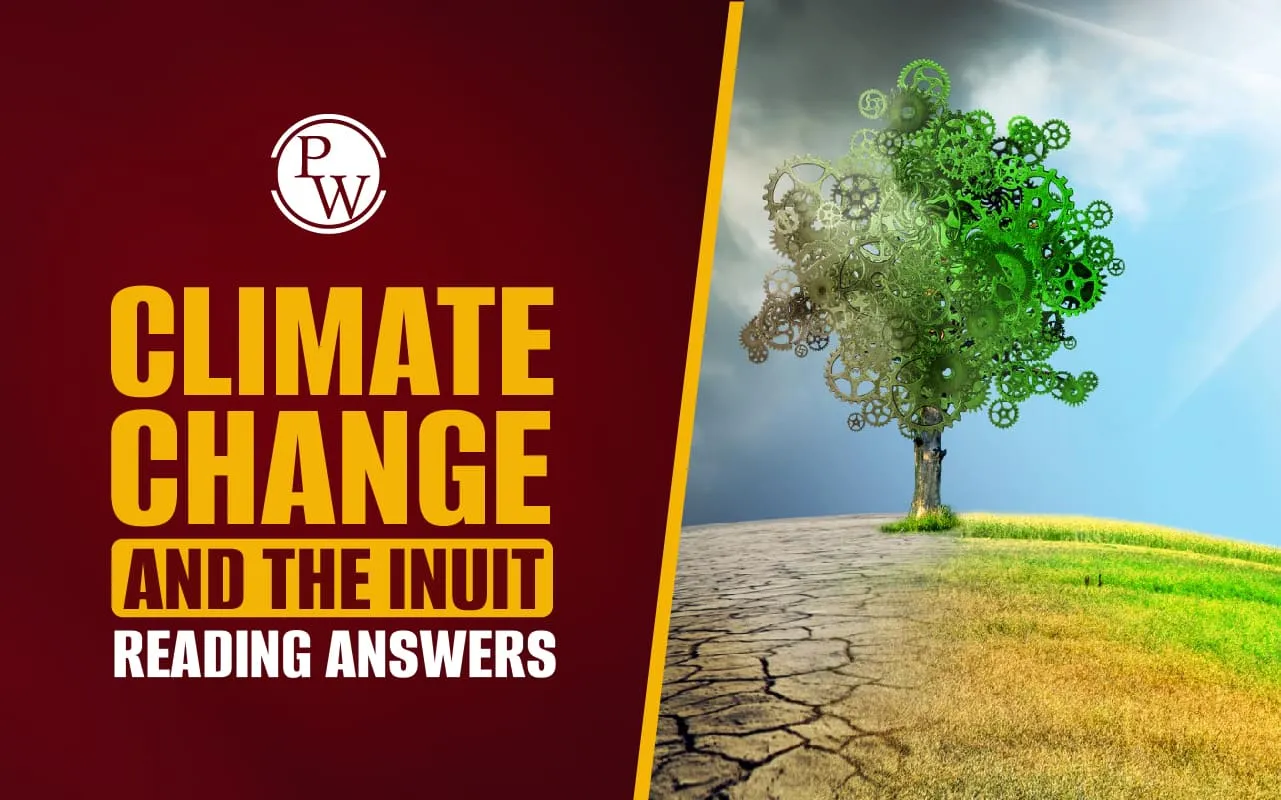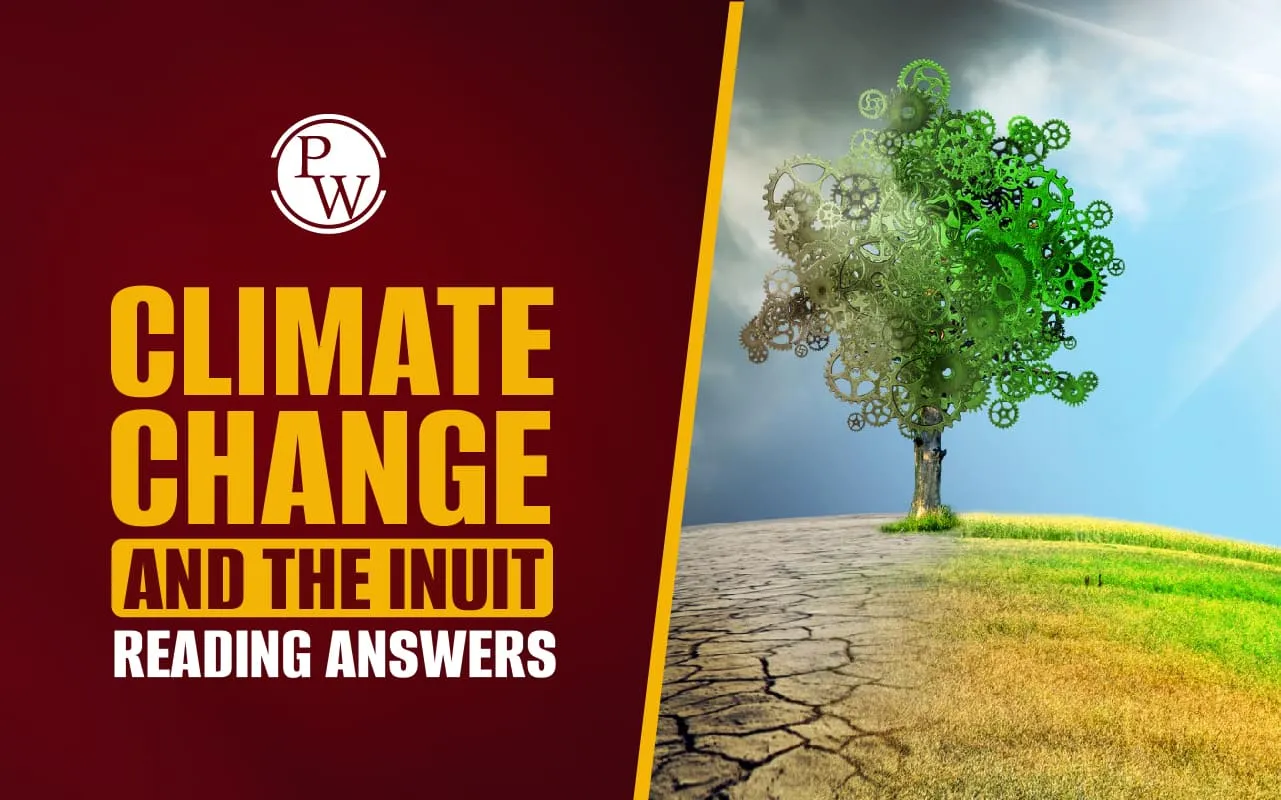

Climate Change and The Inuit Reading Answers: The IELTS Reading section features a detailed passage on Climate Change and The Inuit, examining how climate change is impacting the Inuit people’s lifestyle, environment, and health in the Arctic. This passage includes 14 questions that assess comprehension and analytical skills. The questions are divided into two categories, requiring students to analyze the environmental changes, the Inuit's adaptation strategies, and the scientific collaboration involved. Candidates should aim to complete this section within 20 minutes. Climate Change and The Inuit Reading Answers is a common IELTS Reading test topic, making it essential for students to practice similar passages to improve their reading speed and accuracy.
Climate Change and The Inuit Reading Answers Passage
You should ideally spend about 20 minutes on Questions 1-14.
Climate Change and the Inuit
The threat posed by climate change in the Arctic and the problems faced by Canada's Inuit people
-
Unusual incidents are being reported across the Arctic. Inuit families going off on snowmobiles to prepare their summer hunting camps have found themselves cut off from home by a sea of mud, following early thaws. There are reports of igloos losing their insulating properties as the snow drips and refreezes, of lakes draining into the sea as permafrost melts, and sea ice breaking up earlier than usual, carrying seals beyond the reach of hunters. Climate change may still be a rather abstract idea to most of us, but in the Arctic it is already having dramatic effects - if summertime ice continues to shrink at its present rate, the Arctic Ocean could soon become virtually ice-free in summer. The knock-on effects are likely to include more warming, cloudier skies, increased precipitation and higher sea levels. Scientists are increasingly keen to find out what's going on because they consider the Arctic the 'canary in the mine' for global warming - a warning of what's in store for the rest of the world.
-
For the Inuit the problem is urgent. They live in precarious balance with one of the toughest environments on earth. Climate change, whatever its causes, is a direct threat to their way of life. Nobody knows the Arctic as well as the locals, which is why they are not content simply to stand back and let outside experts tell them what's happening. In Canada, where the Inuit people are jealously guarding their hard-won autonomy in the country's newest territory, Nunavut, they believe their best hope of survival in this changing environment lies in combining their ancestral knowledge with the best of modern science. This is a challenge in itself.
-
The Canadian Arctic is a vast, treeless polar desert that's covered with snow for most of the year. Venture into this terrain and you get some idea of the hardships facing anyone who calls this home. Farming is out of the question and nature offers meagre pickings. Humans first settled in the Arctic a mere 4,500 years ago, surviving by exploiting sea mammals and fish. The environment tested them to the limits: sometimes the colonists were successful, sometimes they failed and vanished. But around a thousand years ago, one group emerged that was uniquely well adapted to cope with the Arctic environment. These Thule people moved in from Alaska, bringing kayaks, sleds, dogs, pottery and iron tools. They are the ancestors of today's Inuit people.
-
Life for the descendants of the Thule people is still harsh. Nunavut is 1.9 million square kilometres of rock and ice, and a handful of islands around the North Pole. It's currently home to 2,500 people, all but a handful of them indigenous Inuit. Over the past 40 years, most have abandoned their nomadic ways and settled in the territory's 28 isolated communities, but they still rely heavily on nature to provide food and clothing. Provisions available in local shops have to be flown into Nunavut on one of the most costly air networks in the world, or brought by supply ship during the few ice-free weeks of summer. It would cost a family around £7,000 a year to replace meat they obtained themselves through hunting with imported meat. Economic opportunities are scarce, and for many people state benefits are their only income.
-
While the Inuit may not actually starve if hunting and trapping are curtailed by climate change, there has certainly been an impact on people's health. Obesity, heart disease and diabetes are beginning to appear in a people for whom these have never before been problems.There has been a crisis of identity as the traditional skills of hunting, trapping and preparing skins have begun to disappear. In Nunavut's 'igloo and email' society, where adults who were born in igloos have children who may never have been out on the land, there's a high incidence of depression.
-
With so much at stake, the Inuit are determined to play a key role in teasing out the mysteries of climate change in the Arctic. Having survived there for centuries, they believe their wealth of traditional knowledge is vital to the task. And Western scientists are starting to draw on this wisdom, increasingly referred to as 'Inuit Qaujimajatuqangit', or IQ. 'In the early days scientists ignored us when they came up here to study anything. They just figured these people don't know very much so we won't ask them,' says John Amagoalik, an Inuit leader and politician. 'But in recent years IQ has had much more credibility and weight.' In fact it is now a requirement for anyone hoping to get permission to do research that they consult the communities, who are helping to set the research agenda to reflect their most important concerns. They can turn down applications from scientists they believe will work against their interests, or research projects that will impinge too much on their daily lives and traditional activities.
-
Some scientists doubt the value of traditional knowledge because the occupation of the Arctic doesn't go back far enough. Others, however, point out that the first weather stations in the far north date back just 50 years. There are still huge gaps in our environmental knowledge, and despite the scientific onslaught, many predictions are no more than best guesses. IQ could help to bridge the gap and resolve the tremendous uncertainty about how much of what we're seeing is natural capriciousness and how much is the consequence of human activity.
| IELTS Exam Important Links | |
|---|---|
| IELTS Reading Band Score | IELTS Listening Band Score |
| IELTS Speaking Band Score | IELTS Writing Band Score |
Climate Change and The Inuit Reading Answers Sample Questions
Questions 1-8
Do the following statements agree with the information given in the reading passage?
In boxes 1-8 on your answer sheet, write:
-
TRUE if the statement agrees with the information
-
FALSE if the statement contradicts the information
-
NOT GIVEN if there is no information on this
-
The Arctic Ocean is expected to remain covered with ice throughout the summer for the next few decades.
-
Inuit communities have refused to cooperate with outside researchers studying climate change.
-
The Thule people migrated from Alaska to the Arctic region about a thousand years ago.
-
Most Inuit communities are connected by a reliable road network.
-
The cost of replacing hunted meat with imported meat is relatively low for Inuit families.
-
The Inuit have experienced a rise in health issues such as obesity and diabetes due to changes in diet.
-
Traditional hunting skills are becoming more common among young Inuit people.
-
Western scientists have always valued and respected the Inuit's traditional knowledge of the Arctic.
Questions 9-14
The above reading passage has 7 paragraphs, A–G.
Which paragraph contains the following information? Write the correct letter A–G in the boxes 9-14 on your answer sheet.
NB: You may use any letter more than once.
-
An example of how early thawing has affected Inuit hunting practices.
-
Historical background on how the Inuit’s ancestors adapted to the Arctic environment.
-
The importance of integrating traditional knowledge with scientific research.
-
A reference to the Inuit’s ability to influence scientific research projects.
-
Description of the geographical challenges faced by the Inuit people.
-
A mention of health problems emerging due to dietary changes.
Climate Change and The Inuit Reading Answers with Explanations
-
FALSE
-
Location: Paragraph A
-
Reference: "If summertime ice continues to shrink at its present rate, the Arctic Ocean could soon become virtually ice-free in summer."
-
Explanation: The statement contradicts the passage, which mentions that the Arctic Ocean might soon become ice-free in summer, not that it will remain covered with ice.
-
FALSE
-
Location: Paragraph F
-
Reference: "It is now a requirement for anyone hoping to get permission to do research that they consult the communities, who are helping to set the research agenda."
-
Explanation: The passage states that the Inuit communities are actively participating in scientific research, not refusing to cooperate.
-
TRUE
-
Location: Paragraph C
-
Reference: "But around a thousand years ago, one group emerged that was uniquely well adapted to cope with the Arctic environment. These Thule people moved in from Alaska…"
-
Explanation: The passage confirms that the Thule people migrated from Alaska about a thousand years ago.
-
FALSE
-
Location: Paragraph D
-
Reference: "Nunavut is 1.9 million square kilometres of rock and ice… most have abandoned their nomadic ways and settled in the territory's 28 isolated communities."
-
Explanation: The passage indicates that the communities are isolated, implying that there is no reliable road network connecting them.
-
FALSE
-
Location: Paragraph D
-
Reference: "It would cost a family around £7,000 a year to replace meat they obtained themselves through hunting with imported meat."
-
Explanation: The passage states that replacing hunted meat with imported meat is very expensive.
-
TRUE
-
Location: Paragraph E
-
Reference: "Obesity, heart disease and diabetes are beginning to appear in a people for whom these have never before been problems."
-
Explanation: The passage confirms that these health issues are now affecting the Inuit due to dietary changes.
-
FALSE
-
Location: Paragraph E
-
Reference: "There has been a crisis of identity as the traditional skills of hunting, trapping and preparing skins have begun to disappear."
-
Explanation: The passage states that traditional skills are declining, not becoming more common.
-
FALSE
-
Location: Paragraph F
-
Reference: "'In the early days scientists ignored us when they came up here to study anything.'"
-
Explanation: The passage states that initially, scientists ignored Inuit knowledge, contradicting the idea that it was always valued.
-
A
-
Location: Paragraph A
-
Reference: "Inuit families going off on snowmobiles… found themselves cut off from home by a sea of mud, following early thaws."
-
Explanation: This example illustrates how early thawing has affected Inuit hunting.
-
C
-
Location: Paragraph C
-
Reference: "These Thule people moved in from Alaska… They are the ancestors of today's Inuit people."
-
Explanation: This paragraph discusses the migration and adaptation of the Thule people.
-
F
-
Location: Paragraph F
-
Reference: "They believe their wealth of traditional knowledge is vital to the task… Western scientists are starting to draw on this wisdom."
-
Explanation: This shows the integration of traditional knowledge with scientific research.
-
F
-
Location: Paragraph F
-
Reference: "They can turn down applications from scientists they believe will work against their interests…"
-
Explanation: This confirms the Inuit's influence on research projects.
-
D
-
Location: Paragraph D
-
Reference: "Nunavut is 1.9 million square kilometres of rock and ice…"
-
Explanation: This describes the challenging geographical conditions of the Inuit's environment.
-
E
-
Location: Paragraph E
-
Reference: "Obesity, heart disease and diabetes are beginning to appear…"
-
Explanation: This explains the emergence of health problems due to dietary changes.
Also Read:
- Should You Use All Capital Letters in the IELTS Listening and Reading Tests
- IELTS Reading Mistakes
- How to Improve IELTS Reading Score
- How to Manage Time in IELTS Reading
Guidance of PW IELTS
Physics Wallah offers multiple online IELTS courses for all students. Follow the IELTS pages to better prepare for the exam.
| What is IELTS Exam? | Documents Required for IELTS Registration |
| IELTS exam eligibility requirements | IELTS Exam Fees |
| IELTS test results | IELTS Exam Pattern |
Climate Change and The Inuit Reading Answers FAQs
What challenges are the Inuit facing due to climate change?
How is Inuit traditional knowledge contributing to scientific research on climate change?
What health issues have emerged among the Inuit due to lifestyle changes?
How has the Inuit lifestyle changed over the past 40 years?
How are Inuit communities influencing scientific research in their region?












